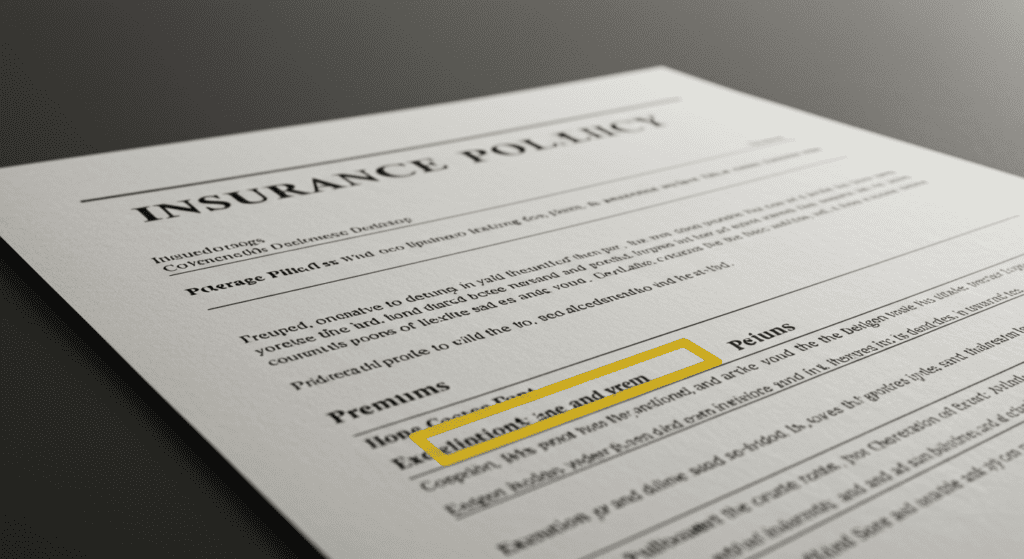- Defining Policy Exclusions: What They Are and Why They Matter
- The Role of Policy Limitations in Insurance Coverage
- Common Types of Exclusions in Insurance Policies
- Differentiating Between Exclusions and Exceptions
- The Impact of Policy Exclusions on Claims Processing
- Legal Frameworks Governing Policy Limitations
- How to Identify and Understand Your Policy’s Exclusions
- Strategies for Mitigating the Effects of Limitations in Coverage
- Case Studies: Real-Life Examples of Policy Exclusions and Limitations
- Tips for Consumers: Navigating Your Policy for Better Protection
1. Defining Policy Exclusions: What They Are and Why They Matter
Policy exclusions are specific conditions or circumstances that a policy does not cover. They play a crucial role in determining the scope of insurance protection. Every insurance contract contains a list of exclusions that clarify which events or losses are not covered by the policyholder’s agreement. This is important because exclusions manage the insurer’s risk and help maintain reasonable premiums for consumers. They protect the insurance company from paying claims for events that fall outside the intended risk pool. Understanding these exclusions ensures that policyholders know exactly what is safeguarded and what is not.

2. The Role of Policy Limitations in Insurance Coverage
While exclusions remove specific risks from covered events, policy limitations narrow down the extent or amount of coverage provided even when a claim is valid. Limitations can take several forms. For instance, there might be a cap on the payout for certain types of claims or a deductible that must be met before benefits are provided. These limitations are designed to control costs for insurers while balancing the interests of policyholders. They ensure that policyholders are aware that even if a claim falls within coverage, the compensation might not cover the full cost of a loss. By understanding policy limitations, consumers can better plan and select additional coverage if needed.
3. Common Types of Exclusions in Insurance Policies
Insurance policies generally contain several types of exclusions that clarify which circumstances are ineligible for compensation. Common exclusions include acts of war or terrorism, damages resulting from natural disasters like floods or earthquakes (unless specifically included via endorsements), and losses from intentional acts. Some policies may also exclude pre-existing conditions or hazardous activities. These exclusions are not arbitrary; they reflect the risk management principles of insurance companies. When reviewing a policy, it is critical to look for any language that uses phrases such as “not covered” or “except” and note if endorsements are available that might extend coverage beyond the standard exclusions.

4. Differentiating Between Exclusions and Exceptions
It is important to understand the difference between exclusions and exceptions. Exclusions are conditions that are not covered under the policy at all, regardless of any circumstances. Exceptions, on the other hand, are specific situations where an exclusion does not apply. For example, a basic auto insurance policy might exclude certain types of vehicle modifications, but an exception could be made if those modifications are approved by the manufacturer or come with additional documentation. Recognizing this difference can help policyholders determine if additional endorsements are needed to obtain complete protection. The subtle distinctions can affect claims processing and overall satisfaction with the policy.
5. The Impact of Policy Exclusions on Claims Processing
Policy exclusions can have a significant impact when it comes to submitting and processing claims. If a policyholder experiences a loss that falls under an exclusion, their claim will likely be denied, leaving them financially vulnerable. Insurance companies rely on exclusions to reduce liability, and this can sometimes lead to disputes if the wording of the policy is unclear. In such cases, careful documentation and a clear understanding of the policy’s language become essential. Policyholders should always review their policies in detail and consult with their insurance agent if any terms seem ambiguous. This proactive approach can mitigate the risk of unexpected denial during an already stressful claims process.

6. Legal Frameworks Governing Policy Limitations
The insurance industry is regulated by a complex legal framework that governs policy limitations. These legal structures ensure that both insurers and policyholders are treated fairly in the marketplace. In many countries, regulatory authorities have set guidelines that specify the limits on premiums, coverage amounts, and acceptable exclusions. When a dispute arises, courts will often rely on these frameworks to interpret the policy’s language. Furthermore, legislative changes can have significant impacts on how limitations and exclusions are applied. Staying informed about these regulatory developments is essential for both consumers and insurance companies. Policyholders should periodically review updates to ensure their coverage remains compliant with current laws.
7. How to Identify and Understand Your Policy’s Exclusions
A thorough review of your insurance policy is key to identifying and understanding its exclusions. Start by reading all sections of your policy, focusing on the fine print where exclusions are commonly listed. Look for sections titled “Exclusions,” “Limitations,” or “Conditions” to get a clear picture of what your policy does not cover. It can also be beneficial to ask your insurance agent for clarification on any ambiguous language. Many insurers provide summaries or illustrations to help consumers understand complex terms. Additionally, online resources and consumer forums can offer insights and real-life experiences regarding standard exclusions in various types of policies. This proactive research can help ensure that nothing catches you off guard during a claim.

8. Strategies for Mitigating the Effects of Limitations in Coverage
There are several effective strategies to mitigate the potential negative effects of coverage limitations. First, consider purchasing additional endorsements or rider policies that offer extended coverage. These supplemental policies can cover specific risks that the primary policy excludes or limits. Another strategy is regular policy reviews with your insurance advisor; adjustments may be necessary as personal or business circumstances evolve. Policyholders might also research alternative insurance providers to find a policy structure that more closely matches their needs. Lastly, adopting risk management practices, such as installing safety systems or practicing preventive maintenance, can help reduce the likelihood of a loss occurring. These strategies together offer a comprehensive way to bridge any gaps in standard insurance policies.
9. Case Studies: Real-Life Examples of Policy Exclusions and Limitations
Examining case studies provides practical insights into how policy exclusions and limitations operate in real-life scenarios. One example involves homeowners who discovered their insurance did not cover flood damage caused by a severe storm. Despite regular premiums, the loss left the homeowner facing significant repair costs. In another instance, an auto insurance claim was partially denied because the policy had a specific limitation regarding aftermarket modifications on the vehicle. These examples highlight the importance of understanding the language in your policy. Consumers who engaged with their insurance providers proactively were able to find workarounds, such as purchasing additional flood coverage or adjusting vehicle modification disclosures, proving that awareness and action can mitigate risk effectively.

10. Tips for Consumers: Navigating Your Policy for Better Protection
Consumers can take several practical steps to ensure better protection from the limitations and exclusions in their policies. First, always take the time to review your policy documents carefully. Ask questions about any confusing terms and request examples that clarify ambiguous language. Second, maintain an open dialogue with your insurance agent. They can provide insights into whether certain exclusions might be mitigated through endorsements or alternative policies. Third, reassess your insurance needs periodically, especially after major life events such as purchasing a new home, starting a business, or experiencing significant lifestyle changes. Fourth, educate yourself using trusted online resources and consider speaking with an independent insurance advisor. Finally, consider multiple policy quotes. Different insurers may structure their policies differently, with varying degrees of exclusions and limitations. By comparing options, you can find a policy that best aligns with your risk tolerance and coverage requirements.
Understanding policy exclusions and limitations is critical to managing risk and ensuring that you are adequately protected. Policy exclusions define the boundaries of what is not covered, highlighting the specific risks that are deliberately omitted from the policy. Limitations, meanwhile, narrow the scope of compensation even when a loss is covered. Both play a vital role in shaping the claims process. Legal frameworks support these exclusions through regulatory oversight, ensuring that policies maintain consistent standards across the market.
As consumers navigate the complexities of insurance, these strategies and insights can lead to better coverage decisions, ultimately safeguarding your finances in times of need. Keep these tips in mind as you review, compare, and tailor your insurance policies, ensuring that when you need to file a claim, you do so with the confidence that you have taken all possible measures for your protection.
